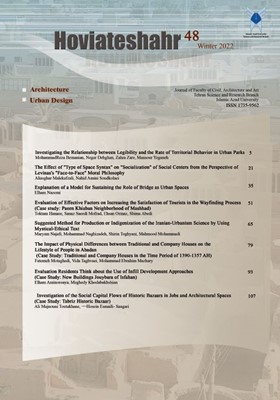Investigation of the Social Capital Flows of Historical Bazaars in Jobs and Architectural Spaces Case Study: Tabriz Historic Bazaar
Subject Areas : architectureAli Majnouni- Toutakhane 1 * , Hosein Esmaeeili Sangari 2
1 - Ph.D Candidate in Architecture, Department of Architecture Engineering, Faculty of Art and Architecture, University of Bonab, Bonab, Iran
2 - Assistant Professor, Academic Staff of the Cultural Heritage and Tourism Institute, Tehran, Iran.
Keywords: Architectural Spaces, Tabriz, Historical Bazaar, Social Capital, Human factors,
Abstract :
Nowadays, Historic Bazaars are considered the backbone of cities, and in addition to business development in cities, they are also the identity of the city and citizens. Historical Bazaars in Iran have continued to function for thousands of years because of the intersection of economics, culture, religion, and education, and the main reason for this is the presence of very rich social capital on the market. Not only in Iran but also globally, the historic bazaar of Tabriz is the most important bazaar recognized and registered by UNESCO as an international heritage. A variety of economic and social activities can be observed in this bazaar. The necessity of examining the status of social capital in the historic bazaar led to the present study aimed at examining the social capital in the historical bazaar of Tabriz in terms of architectural occupations and spaces. The research is of applied type, and its nature is descriptive-analytical. The statistical population of this research is citizens of Tabriz's historical bazaar. A Five-Likert scale questionnaire was used to assess social capital status. The validity of the questionnaire was confirmed by university professors, which was calculated by Cronbach's alpha 0.896. The results of the research findings using factor analysis model showed that 82 jobs were summarized in 15 major occupational groups and ranked as important as cultural-religious, jewelry, grocery, handicrafts, leather, carpet, textile industries, protein jobs, canteen, home appliances, computer services, building materials, chemicals, electrical appliances, and financial services named. The results of the regression test on the highest amount of social capital among the clients of traditional business applications in the traditional market showed that high-end jobs had a higher correlation rate than low-wage jobs. Then, based on the results of the multivariate regression test, it can be concluded that the sum of the variables studied in this study is capable of explaining 68.7% of the variance related to the amount of social capital available between businesses and citizens in Tabriz historical market complex. Moreover, the results of the regression test on the correlation between jobs and different segments of the Tabriz market showed that the order space was 0.415, the mosques were 0.386, the inns 0.364, the teams were 0.364. There are positive and significant correlations between social capital. The size of the shops, bathrooms, and schools was not significantly correlated with the amount of social capital. Multivariate regression analysis was used to assess the status of social capital in the Tabriz market in terms of human variables. Finally, the consequences of the multivariate regression test on the correlation between human variables with social capital in the historical market of Tabriz showed that, respectively, citizen's age (0.512), shopkeeper age (0.416), number of shops bought (0.369), shopkeeper gender (0.221) and citizen gender (0.220), have a significant positive correlation with social capital. As a result, based on the findings of the study, practical suggestions were made to strengthen the amount of social capital in the market as well as market management in terms of market social capital.
http://ensani.ir/file/download/article/20110130171319-(1754).pdf
https://www.sid.ir/fa/journal/ViewPaper.aspx?id=165475
https://sppl.ui.ac.ir/article_23618.html
https://www.sid.ir/fa/journal/ViewPaper.aspx?id=198598
https://www.sid.ir/fa/journal/ViewPaper.aspx?id=127679
http://ph.aui.ac.ir/browse.php?a_id=427&sid=1&slc_lang=fa
http://ebtp.malayeriau.ac.ir/article_527322.html
https://www.sid.ir/fa/journal/ViewPaper.aspx?ID=200768
https://www.sid.ir/Fa/Journal/ViewPaper.aspx?ID=483897
http://rahbord.csr.ir/issue_17051_17057.html
https://jhgr.ut.ac.ir/article_24490.html
https://indjst.org/articles/conservation-of-historic-urban-core-in-traditional-islamic-culture-case-study-of-isfahan-city
https://journals.sagepub.com/doi/abs/10.1111/etap.12118
https://link.springer.com/article/10.1007%2Fs10902-013-9441-z
https://www.jstor.org/stable/44258961
https://www.sciencedirect.com/science/article/pii/S2095263513000769?via%3Dihub
_||_

